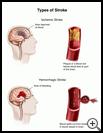
Stroke (Cerebrovascular Accident), Hemorrhagic, Discharge Information
What is a stroke?
A stroke is damage to part of the brain when its blood supply is suddenly slowed or stopped. A stroke may also be called a cerebral vascular accident or CVA. The part of the brain that does not get enough blood dies and can no longer function.
A hemorrhagic stroke happens when an artery in the brain breaks and bleeds into the brain. They often happen without warning. Any of the following factors can increase the risk of a hemorrhagic stroke:
- High blood pressure
- Cigarette smoking
- Cocaine use
- Bleeding disorders or blood vessel problems, such as a brain aneurysm
- Use of certain medicines that prevent blood from clotting
Symptoms of a stroke include:
- Sudden numbness or weakness of the face, arm or leg, usually on one side of your body
- Sudden trouble walking or loss of balance
- Sudden trouble speaking or thinking clearly
- Sudden dizziness or severe headache
- Sudden trouble seeing in one or both eyes
- Nausea and vomiting
How can I take care of myself when I go home?
How long it takes to get better depends on the cause of your stroke, your treatment, how well you recover, your overall health, and any complications you may have. Talk to your healthcare provider about the cause of your stroke. Follow your provider’s advice on how to take care of yourself to avoid another stroke.
Management
- Your provider will give you a list of your medicines when you leave the hospital.
- Know your medicines. Know what they look like, how much you should take each time, how often you should take them, and why you take each one.
- Take your medicines exactly as your provider tells you to.
- Carry a list of your medicines in your wallet or purse. Include any nonprescription medicines and supplements on the list.
- Talk to your provider before you use any other medicines, including nonprescription medicines.
- Your provider may prescribe medicine to:
- Treat other conditions that may have been a risk factor for your stroke, such as high blood pressure
- Treat pain
- Your provider may recommend other types of therapy to help relieve pain, other symptoms, or side effects of treatment.
- You may need to continue your stroke rehabilitation program after you leave the hospital to help you adjust to some of the functions you may have lost due to the stroke. This may be done in an intensive rehabilitation center or at home. Most rehabilitation programs include:
- Physical therapy to help you regain or maintain muscle strength and teach you ways to move safely
- Occupational therapy to help you relearn ways to do the tasks that you previously did
- Speech therapy to help you if you have problems with swallowing, speaking, or understanding words
- Therapy may include skin care and training to help you control your bladder and bowels.
- You may need help with daily activities.
- Follow the treatment plan your healthcare provider prescribes.
- Follow activity restrictions, such as not driving or operating machinery, as recommended by your healthcare provider or pharmacist, especially if you are taking pain medicines.
- Take care of your health. Try to get at least 7 to 9 hours of sleep each night. Eat a healthy diet and try to keep a healthy weight. If you smoke, try to quit. If you want to drink alcohol, ask your healthcare provider how much is safe for you to drink. Learn ways to manage stress. Exercise according to your healthcare provider's instructions.
- Ask your healthcare provider if there are any foods or medicines you should avoid.
Appointments
- Follow your provider’s instructions for follow-up appointments.
- Keep appointments for any testing you may need.
Talk with your provider about any questions or concerns you have.
Call emergency medical services or 911 if you have new or worsening:
The acronym FAST describes stroke symptoms and needed action. The symptoms come on FAST and may include:
- Face/Head:
- Weakness, numbness, drooping, tingling of face (may just be on one side)
- Trouble seeing (one or both eyes)
- Severe headache
- Trouble thinking
- Trouble swallowing
- Feeling dizzy along with one or more of the symptoms listed above
- Arm/Leg:
- Weakness, numbness, or tingling in your arm, or leg (usually on just one side of your body)
- Trouble walking, moving your arm or leg
- Speech: Trouble talking or understanding speech
- Time: Call 911 for emergency help right away if you have symptoms of a stroke.
You should also call emergency medical services or 911 if you have new or worsening:
- Loss of bowel or bladder control
- Seizures or convulsions
If you have any of these symptoms, do not drive yourself.
Call your healthcare provider if you have new or worsening:
- Confusion
- Personality changes
- Dizziness or lightheadedness
- Headache that will not go away after treatment
- Forgetfulness
Last modified: 2016-02-25
Last reviewed: 2016-02-24

